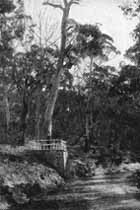2. THE EXPLORERS' TREE, KATOOMBA

In the meantime, we shall jump ahead to the years after the railway line was extended west over the Blue Mountains and local myth-making began in earnest. The railway opened the way for the growth of towns and a settled population that wanted to feel at home here. These early citizens of the Mountains (often people who divided their time between the city and the 'hills') found themselves living in a landscape that seemed devoid of any recognisable history and to remedy this they turned to the explorers, to men who could be fashioned into “heroes of national stature”. (Griffiths, Tom. p.157.)
On 26 August a letter, written by the botanist the Rev. William Wools, appeared in The Sydney Morning Herald. Discussing eucalypts he wrote: “To show how little some of the trees alter in the course of half a century, I may mention that the blackbut on which the late Mr. W. Lawson cut his initials with a tomahawk in 1813 still presents the letters as legible as ever.”
While this is the earliest known reference to The Explorers' (or Marked) Tree at Pulpit Hill, in subsequent decades it was to become the centre of considerable attention. Eccleston Du Faur, a tireless promoter of the Blue Mountains then working for the Department of Lands, drew “the L tree” to the attention of his office during the 1870s and, in the early 1880s, a number of men with interests in the Blue Mountains including Sir Henry Parkes and W.R.Piddington initiated a movement which resulted in a wall and fence being erected around the tree in 1884.
Unfortunately, this public effort to raise the profile of the tree was not without its problems. In the first place the author of the original inscription attached to the wall got his history wrong and declared that this was the “farthest point reached by the explorers”. This caused some consternation, particularly among descendants of the famous three, and was eventually corrected. The second problem was more insidious and less easy to deal with. Ironically, the wall meant to preserve the tree appears to have eventually killed it and, by the early years of the 20th Century, the dead trunk had become dangerous enough for it to be cut off leaving only the stump. The amputated upper portion of the tree was taken to the Hydro Majestic Hotel at Medlow Bath where it remained as an 'attraction' on which visitors pinned their cards until it was destroyed by fire in the early 1920s.
In the years following its 'discovery', descriptions of the tree and what precisely was carved into its bark varied enormously (from a single L to the complete initials of all three explorers) and there was some intense debate on the subject of its validity (eg. in the letter columns of the Sydney Morning Herald in 1905). Despite this, amid the swelling patriotism and historical reflection surrounding Australia's celebration of its Centenary in 1888 and the subsequent march towards Federation and nationhood, the Explorers' Tree provided a local focus. “The long centuries”, one traveller observed in 1893, will “cast a halo over the place” just as they have done to important historical sites in Britain. By the first decade of the 20th Century the tree had become a widely venerated relic and a symbolic link with the past.
© John Low 2001

